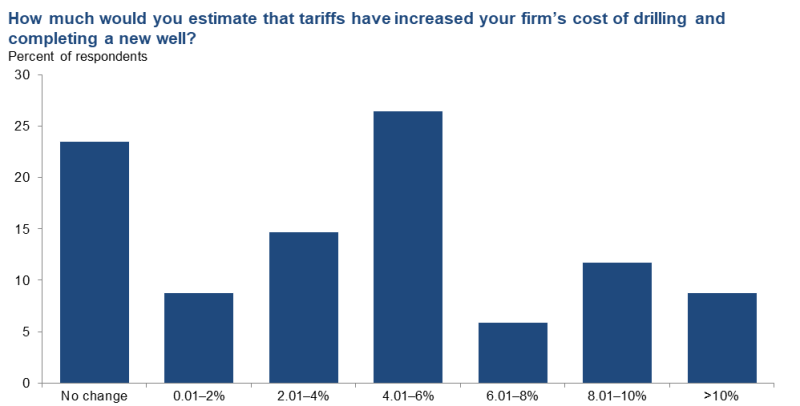US shale producers are dialing back activity more than expected since the start of the year as they contend with middling oil prices and mounting water management challenges in parts of the patch. This is according to the results of the latest energy survey by the US Federal Reserve Bank of Dallas.
Overall, the survey shows that business activity among the surveyed firms shifted negative in the second quarter, falling from 3.8 to –8.1.
The outlook index—a measure of how companies view the future—was relatively unchanged, reflecting what the Dallas Fed described as “slight pessimism.” Additionally, the outlook uncertainty index rose by 4 points to 47.1, signaling what the Fed called “elevated uncertainty.”
The quarterly survey was conducted between 18 and 26 June and drew responses from executives at 136 energy firms, including 91 oil and gas companies and 45 oilfield service providers.
The Dallas Fed classifies 12 of the oil and gas companies as large producers, defined as those with output exceeding 10,000 B/D. Among this large-operator group, nine said they plan to drill fewer wells than they did at the beginning of the year. Of those, five reported their drilling plans had “decreased significantly.” Only two said they plan to “slightly” increase drilling activity.
US Tariffs Taking a Toll?
When asked what’s driving the slowdown, only about one-third of oil and gas companies that responded said the recent increase in US tariffs on imported steel—from 25% to 50%—is directly affecting their drilling plans. Roughly half said the tariffs have had no impact, while 22% said it’s “too soon to know.”
On the cost side, a quarter of producers reported no increase in well costs from the tariffs. Another quarter cited a 4–6% rise in costs, while 18% said they’re seeing increases between 6–10%. About 9% said their costs are up 10% or more.
But tariffs may not be the primary concern. Perhaps more pressing for oil and gas executives is the price of oil itself, which had climbed to an average of nearly $70/bbl during the survey period in late June amid renewed conflict between Israel and Iran.
If prices fall to an average of $60/bbl over the next 12 months, two-thirds of the 85 oil and gas executives who responded to the question said they would reduce production. If prices drop to $50/bbl, 88% said they would cut production either slightly or significantly—split roughly evenly between the two responses.

Produced Water Problems
Water management is emerging as a notable challenge for shale producers, particularly in the Permian Basin where overpressurization of produced water disposal zones has led to new injection rules. According to the Dallas Fed survey, most oil and gas executives expect produced water issues to begin limiting drilling and completion activity in the region within the next 5 years.
More than 100 oil and gas executives responded to questions about the issue. Only a quarter said produced water management posed no constraint to their operations. In contrast, 42% said water management was a “slight constraint,” while a third called it a “significant constraint.”
The Dallas Fed noted that responses varied by company size. Larger operators were more likely to report no expected challenges compared with smaller producers and oilfield service providers.
In the survey’s written comments, one oil and gas executive said disposal well costs have already risen to “injurious levels putting strong pressure on margins.”
Others downplayed the concerns, attributing them to political factors or suggesting that increased recycling efforts could ease the burden.
Still, for some, the problems with produced water disposal are being felt today. “We have already seen shallow injection zones significantly impact our development and future drilling plans,” another executive wrote.
Oilfield Services Suggest Downturn
Oilfield service firms—often the first to feel the effects of capital pullbacks—expressed more pessimism than their operator counterparts in the latest Dallas Fed survey. Their frustration spanned falling rig activity, a growing inventory of idle equipment, pricing uncertainty around steel casing, and contract rates that remain below sustainable levels.
Many respondents said market conditions are also being strained by a combination of oil oversupply and ongoing industry consolidation. Sentiment around steel tariffs varied. One service provider said the added costs are being passed on to customers, while another reported that operator clients are largely refusing to absorb those costs.
Despite the brief rise in oil and gas prices following the conflict in the Middle East, several service firms noted looming job cuts within their client base and a broader shift toward reduced activity.
As one executive put it, “A lengthy downturn is the logical outcome.”


